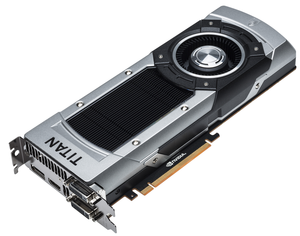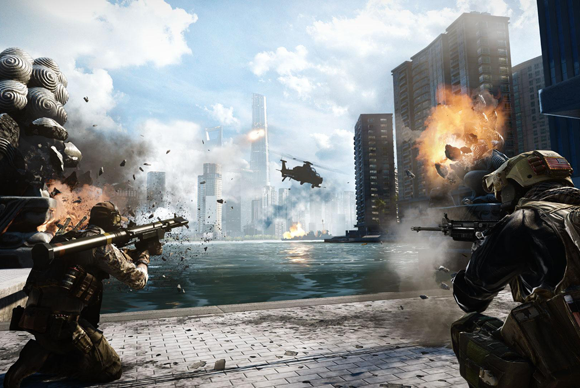DirectX 12 vs. Mantle: Comparing PC gaming's software-supercharged future
After nearly five years of lingering on the same stable release, the next generation of DirectX is finally on its way. But a specter hung over Microsoft's introduction of DirectX 12at GDC on Thursday: AMD's in-house Mantle technology.
While AMD's Raja Koduri was on-hand to say that DirectX 12 and Direct3D 12 was like "getting four generations of hardware ahead," the technology may have never seen the light of day without AMD's goading. After securing deals to create the PlayStation 4 and Xbox One's hardware, the company unveiled Mantle—a new set of console-like application programming interfaces designed to give game developers more direct access to PC hardware, and thus, boost graphics performance.
As Mantle technology began appearing in actual games, AMD officials wondered aloudwhether a new version of DirectX would ever arrive, given Microsoft's strong focus on Xbox. Mere weeks later, here we are, and at first blush DirectX 12 appears awfully similar to Mantle. (That's what happens when you poke the bear!)
So how do Mantle and DirectX 12 stack up? Why should you care about either of them? Let's take a peek at what matters to you, dearest PC gamer.
What's the big deal with Mantle and DirectX 12?
Smoother, faster games, that's what.
The DirectX and OpenGL APIs powering virtually all PC games take a "high level" approach to ensure compatibility with the vast universe of PC hardware. Console developers are used to lower-level, "close-to-the-metal" access that lets them do more powerful things with hardware stemming from the more direct control.
Mantle mimics that by letting games written for Mantle talk directly to the Graphics Core Next architecture at the heart of AMD's Radeon Graphics cores, improving efficiency (read: performance) by reducing CPU bottlenecks.
Microsoft promises similar "console-like" efficiency for DirectX 12, with more efficient graphics rendering and better balancing of workloads across CPU cores, among other tweaks. You can read all the available technical details on the DirectX blog.
Mantle's already shipped in Thief and Battlefield 4, and early results are promising. Though the exact performance increase varies from PC to PC, BF4 frequently saw double-digit-percentage frame rate gains across various test configurations. Given the way Mantle works, so-called "CPU-bound" gaming PCs with low- to mid-range processors and solid graphics cards saw the biggest performance improvement runningBF4 with Mantle.
Can it run on my existing hardware?
There's the kicker for Mantle. While AMD has promised to eventually release a Mantle SDK that Intel and Nvidia could use, that's never realistically going to happen, and Mantle-enabled titles work only with PCs powered by AMD's Radeon technology.
What's more, Mantle doesn't even work on all Radeon hardware, only on recent Radeon hardware built around AMD's Graphics Core Next technology (which is also found in the PS4 and Xbox One). Essentially, you need one of the recently-released Kaveri APUs(which combine CPU and GPU on a single chip) or a 7000-series, R7-series, or R9-series Radeon graphics card. The first Radeon 7000-series graphics cards launched in early 2012.
DirectX 12 should run on a vast swathe of hardware, however. Microsoft expects DX12 to work on 80 percent of all gaming PC hardware shipping today and 50 percent of the total PCs being used when DX12 finally hits the streets. AMD's GCN-based graphics products will support DX12. Every Nvidia graphics card that runs DirectX 11 will also run DirectX 12, as will Intel's most current processors. That's impressive—and DirectX's far-reaching hardware support is one of the reasons the technology became so dominant to begin with.
Will my games play nice with Mantle and DirectX 12?
Hardware support's useless if games don't actually use the new gaming APIs, though. DirectX is the flag-bearer for PC gaming APIs, with the vast majority of Windows PC games being built around it or OpenGL. If DirectX 12 truly works with disparate PC hardware as well as DirectX 11 does, but offers even more efficiency and raw power, there's no reason to think it won't be just as widely adopted.
AMD's fighting more of an uphill battle with Mantle, thanks to its being so tightly bound to GCN-based Radeon hardware. Because of that, in fact, PC developers that offer Mantle optimizations offer it as an extra, beyond traditional DirectX/OpenGL implementations.Thief and Battlefield 4's Mantle-enabled drivers each appeared after the normal versions of the games launched.
But the allure of performance gains and more direct control is strong for developers—especially if they're looking to port over a PC game from the GCN-packing PS4 or Xbox One. Several big-name developers have already dabbled with Mantle: EA DICE (maker ofBattlefield), Crytek (maker of Crysis and Far Cry), Eidos and Square Enix (makers ofThief), and Rebellion Developments (maker of Sniper Elite). Star Citizen, Robert Space Industries' rip-roaring, $40-plus million, crowd-funded game success, will also be Mantle-enabled, as will Oxide's Nitrous game engine.
That's far from a comprehensive list—but it's not a bad start for AMD.
Sweet! So when can I start playing games with Mantle and DirectX 12?
Aaaaaaaand here's DirectX 12's biggest drawback. While you can pick up and start playing Mantle-enabled PC games right now—assuming you have compatible hardware, of course—DirectX 12 won't be available for a long, long time. Microsoft is targeting the first DX12 games to hit stores in holiday 2015. Yes, 2015. And don't forget that game developers took their sweet time pushing out DirectX 11 games back in the day, too.
Ugh.
With such a far-off timetable, Microsoft's announcement of DirectX12 definitely seems to be a response to the threat of Mantle. And with such a far-off timetable, AMD will definitely have the opportunity to woo developers into Mantle's arms.
But no matter which technology "wins" in the long run, gamers win when games perform better—especially if they don't have to buy new hardware to see the improvements.
Even if DirectX 12 launches in a year and a half and promptly smothers AMD's fledgling solution—a pretty likely scenario, if Microsoft's promises come true—we have Mantle to thank for prodding Microsoft out of its DirectX 11 complacence. And if you want to behold the future of "close to the metal" PC gaming today, well, Mantle's the only way to fly.
You must Sign up as a member of Effecthub to view the content.
A PHP Error was encountered
Severity: Notice
Message: Undefined index: HTTP_ACCEPT_LANGUAGE
Filename: helpers/time_helper.php
Line Number: 22
Latest Posts
- Nvidia beta driver boosts performance ‘up to 64%’ in DirectX games, while AMD’s Mantle looks on sadly from the wings
- DirectX 12 is set to supercharge PC gaming
- DirectX 12 vs. Mantle: Comparing PC gaming's software-supercharged future
- Creator of DirectX platform speaking at Multicore World 2014
- Microsoft's DirectX update will bring you 'closer to the metal'







1785 views 0 comments
You must Sign up as a member of Effecthub to join the conversation.